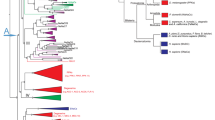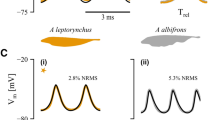Abstract
THE simplest nervous systems known are those of Coelenterate polyps, of which hydra is one. Nerve cells of the common freshwater hydra occur in a diffuse, two-dimensional nerve net dispersed among the epithelial cells of the outer, ectodermal layer1–4. There are also a few nerve cells in the inner, endodermal layer but these are scattered and do not seem to form a continuous net5. Nowhere in a hydra are there nerve cell concentrations or clusters of sufficient complexity to warrant being called ganglia. There have been many behavioural and electrophysiological investigations of hydra6–9, but the function of the nervous system in the control of behaviour is still unclear. In other coelenterates epithelial cells have been shown to be capable of propagating behavioural signals10,11. Several conducting systems coupled with spontaneously active pacemakers have been identified in hydra, but it is not known which of these conducting systems, if any, are neuronal and which result from activity in non-neuronal, epithelial cells. We have investigated the behaviour of Hydra attenuata in effectively nerve-free animals and show that such behaviour as remains, is controlled by non-neuronal cells.
This is a preview of subscription content, access via your institution
Access options
Subscribe to this journal
Receive 51 print issues and online access
$199.00 per year
only $3.90 per issue
Buy this article
- Purchase on Springer Link
- Instant access to full article PDF
Prices may be subject to local taxes which are calculated during checkout
Similar content being viewed by others
References
Bullock, T. H., and Horridge, G. A., Structure and Function in the Nervous Systems of Invertebrates (W. H. Freeman, San Francisco, 1965).
Davis, L. E., Burnett, A. L., and Haynes, J. F., J. exp. Zool., 167, 295–311 (1968).
Lentz, T. L., Primitive Nervous Systems (Yale University Press, New Haven, 1968).
Davis, L. E., Z. Zellforsch. mikrosk. Anat., 123, 1–17 (1972).
Semal-Van Gansen, P., Bull. Acad. R. Belg. Cl. Sci., 38, 718–735 (1952).
Passano, L. M., and McCullough, C. B., J. exp. Biol., 41, 643–664 (1964); 42, 205–231 (1965).
Josephson, R. K., J. exp. Biol., 47, 179–190 (1967).
Kass-Simon, G., Publ. Seto mar. Biol. Lab., 20, 583–594 (1973).
Rushforth, N. B., in Invertebrate Learning, I, (edit. by Corning, W. C., Dyal, J. A., and Willows, A. O. D.), 123–169 (Plenum, New York, 1973).
Mackie, G. O., Am. Zool., 5, 439–453 (1965); Q. Rev. Biol., 45, 319–332 (1970).
Mackie, G. O., and Passano, L. M., J. gen. Physiol., 52, 600–621 (1968).
Campbell, R. D., J. cell. Sci., 21, 1–13, (1976).
Lenhoff, H. M., and Brown, R. D., Lab. Anim., 4, 139–154 (1970).
Rushforth, N. B., Biol. Bull., 140, 255–273 (1971).
Passano, L. M., Proc. natn. Acad. Sci. U.S.A., 50, 306–313 (1963).
Marcum, B. A., and Campbell, R. D., Am. Zool., 16, 186 (1976).
David, C. N., Wilhelm Roux Arch. Entw Mech. Org., 171, 259–268 (1973).
Author information
Authors and Affiliations
Rights and permissions
About this article
Cite this article
CAMPBELL, R., JOSEPHSON, R., SCHWAB, W. et al. Excitability of nerve-free hydra. Nature 262, 388–390 (1976). https://doi.org/10.1038/262388a0
Received:
Accepted:
Published:
Issue Date:
DOI: https://doi.org/10.1038/262388a0
This article is cited by
-
On being a Hydra with, and without, a nervous system: what do neurons add?
Animal Cognition (2023)
-
The enteric nervous system in gastrointestinal disease etiology
Cellular and Molecular Life Sciences (2021)
-
Spontaneous body contractions are modulated by the microbiome of Hydra
Scientific Reports (2017)
-
Innexin gap junctions in nerve cells coordinate spontaneous contractile behavior in Hydra polyps
Scientific Reports (2014)
-
The evolutionary origin of the Runx/CBFbeta transcription factors – Studies of the most basal metazoans
BMC Evolutionary Biology (2008)
Comments
By submitting a comment you agree to abide by our Terms and Community Guidelines. If you find something abusive or that does not comply with our terms or guidelines please flag it as inappropriate.



